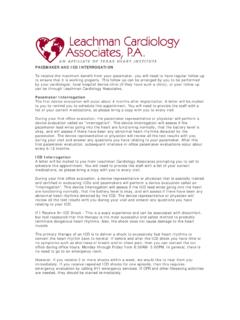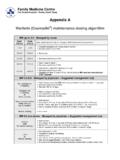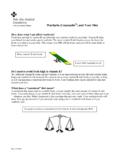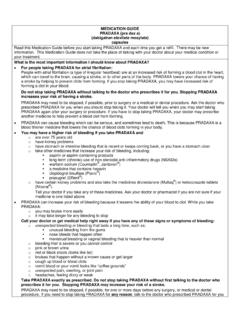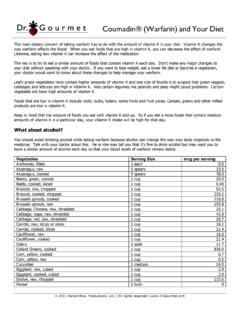Transcription of BI-VENTRICULAR ICD / PACEMAKER What is it?
1 BI-VENTRICULAR ICD / PACEMAKER what is it? A special type of pacing therapy is a device that paces both sides of the lower chambers of the heart, the right and left ventricles, so as to help treat heart failure. This type of pacing is called "biventricular pacing" and the therapy provided by biventricular pacing is called "Cardiac Resynchronization Therapy" (abbreviated as "CRT"). CRT is useful for patients in whom there is uncoordinated activation of the heart muscle. With this problem the pumping function of the heart muscle is not synchronized. Thus, although many portions of the heart muscle may be able to squeeze, because the electrical signals do not activate all the areas of the heart muscle in a simultaneous manner, the heart muscle does not contract in synchrony and the pumping function of the heart is inefficient. CRT helps improve the electrical timing of the heart and tries to restore coordinated pumping action of the ventricles. Although CRT would seem to be important and advantageous for every patient, CRT is beneficial for only certain patients.
2 The decision whether to use CRT will be made by your cardiologist or electrophysiologist. The features to be considered include if you have congestive heart failure and are taking certain medications and if there is evidence for electrical or mechanical dyssynchrony in the heart. An ultrasound picture of the heart (an echocardiogram) may also be helpful to determine if CRT may be beneficial. A biventricular PACEMAKER performs in an identical manner as other pacemakers with regards to delivering electrical stimulus to prevent the heart rate from going too slow. The additional therapy of the CRT device, though, is that it helps coordinate the electrical activity of the heart by simultaneously pacing both lower chambers of the heart to help treat congestive heart failure. This can help reduce shortness of breath and may improve the ability for you to perform daily activities. Implantation of a CRT PACEMAKER is similar to implantation of other pacemakers; however, it does require placement of a third pacing lead.
3 In some patients with an unusual anatomy, placement of this third lead can be difficult. Successful implantation of a CRT device is about 95%. In appropriately selected patients, about 70% of patients respond to CRT. There are many features that can be altered in the programming of the PACEMAKER and, if necessary, the third lead can be turned off. what do I do? For patients who are hospitalized (inpatient): Often the decision to implant the PACEMAKER is not made until after an electrical heart test (electrophysiology study) or after an evaluation by your electrophysiologist. For these patients, any pre-procedure medications will be adjusted by the electrophysiologist and hospital staff. For patients arriving as outpatients: For those patients who are scheduled as an outpatient for implantation of a PACEMAKER , instructions on when and where to arrive to St. Luke s Episcopal Hospital will be provided to you. In general, you will be asked not to eat anything after midnight the day prior to the procedure, except for medications and sips of water.
4 You will likely be instructed on how to adjust or stop blood thinning medication called coumadin or warfarin, if you are taking these medications. If you are on coumadin or warfarin and are scheduled for an outpatient electrical heart test (electrophysiology study) or PACEMAKER implantation procedure and have not received specific instructions regarding how to manage your coumadin/warfarin therapy, please contact us. what will happen? On the day of PACEMAKER implantation, you will be brought into the electrophysiology laboratory. The electrophysiology nursing staff will prepare you for the procedure by placing special adhesive patches on the chest and on other areas of the body. The nurses will also monitor your oxygen level and be certain that there is proper intravenous access to give you medication to help you relax and reduce discomfort. The skin at the site of the implantation will be prepped and intravenous antibiotics will be administered.
5 The site of PACEMAKER implantation will be underneath the clavicle, typically on the left side. An incision is made parallel to the clavicle. This incision is small, usually less than 3 inches) and is made through the skin but not through the chest wall muscle or bones. A PACEMAKER "pocket" is made underneath the skin, and is where the PACEMAKER (approximately the diameter of a half dollar, and the height of 3-4 stacked quarters) will be placed. The PACEMAKER leads will be placed through a vein and are then directed to the heart under x-ray guidance and placed in proper position. These leads record the electrical signals of the heart and are the means of delivering painless electrical impulses from the PACEMAKER to the heart muscle. The leads and the PACEMAKER will then be tested and once they are confirmed to be functioning correctly, the skin will then be closed with absorbable suture material. After PACEMAKER implantation, you will return to your hospital room and will be monitored overnight.
6 Sometimes you will need to stay longer in order to alter your medications or to resume blood-thinning medications such as coumadin. In general, patients are usually discharged the day after implantation. How long does it take? Approximately one - two hours. Post procedure Instructions: You may remove the surgical bandage after 24 hours from the operation (implant), if this was not already done at the hospital. what do I do? When this bandage is removed, you will notice that the skin is brought together with either white strips of tape called "steri-strips"; or, in some patients, the incision may be brought together with "surgical glue" (such as a product called "Dermabond") When you remove the bandage, please do not disturb/remove the steri-strips or the Dermabond. Keep your incision dry. If the skin is closed with steri-strips, when you bathe or shower do not allow water to come in contact with the steri-strips for 2 weeks from the day of implantation of the PACEMAKER or defibrillator (also known as "ICD").
7 If the skin is closed with Dermabond, when you bathe or shower do not allow water to come in contact with the Dermabond for 7 days from the day of implantation of the PACEMAKER or defibrillator. But, please do not scratch or scrub the incision or Dermabond - just let the soapy water gently run over the Dermabond. Never submerge the incision under water (such as in a pool or hot tub) until it has been evaluated by medical personnel about 2 weeks after implantation of the device No ointments, lotions, creams or products of any kind on top of the incision. Do not apply any tape or bandages over the incision. If your incision site has steri-strips, the pieces of tape will be removed by a nurse or your local physician 2 weeks after the procedure. If your incision has Dermabond, do not remove the glue or loosen the edges. The glue will flake off over the next couple of weeks. Finish all antibiotics. Limited Activity for the first 6 weeks after implantation of a PACEMAKER or defibrillator Do not lift anything that weighs more than 10-15 pounds with the arm on the side that the device was placed.
8 Do not lift the elbow on the side that the device was placed above the level of your shoulder. We would like for you to try to limit extending your arm. Do not bear all of your weight on the affected arm. No repetitive activities. Life-Long Restrictions Do not lift greater than 40-50 pounds with the affected arm. Follow-Up Appointments The first evaluation is to check the incision, which is usually performed at 2 weeks after implantation. This evaluation is called a "wound check" and can be done at Leachman Cardiology Associates. You will need to call our office (713-790-9401) to schedule this appointment. The first evaluation of your PACEMAKER will be approximately 3 - 4 months after implantation. This evaluation may require a visit to our office or may be completed via CareLink . The evaluation that is proper for your device is dependent upon the brand and model of the device that was implanted. Precautions & When To Return To Work And Driving Grounded electric equipment such as microwaves, computers and household appliances will not interfere with your cardiac device.
9 The device may be affected by strong electromagnetic fields. You should avoid: industrial strength magnets or magnetic wands used by airport security. You should notify airport security that you have a cardiac device and request a search by hand. standing within range of department store / library security monitor. If you walk in a usual manner past these security monitors, they will not interfere with your device. Problems may occur only if you linger near these monitors. industrial equipment such as power generators and arc welders. an MRI (you may have x-rays or a CAT scan) working on a running car motor. direct impact to the device site such as placing the butt of a rifle or shotgun near the site. using a cordless or cellular phone on the same side as the device. It is OK to use the phone with the ear on the opposite side of the device. Instructions regarding when to return to work depend on the type of work you do. If you have any questions, please contact Leachman Cardiology Associates for assistance.
10 Guidelines regarding when to return to driving are dependent upon why the device was implanted and whether the implanted device is a PACEMAKER or defibrillator. Call Leachman Cardiology Associates (713-790-9401) if: You notice any signs of infection at the site of implantation of the device. These signs include: o Increased swelling or redness o Drainage from your incision o The incision area feels hot to the touch o You have experienced chills or fever You do not receive your permanent device identification card within 10 weeks of implantation of the device. This card is a wallet size card that you should carry with you at all times. It identifies the brand and model number of your cardiac device and the electrodes. You have any additional questions.
